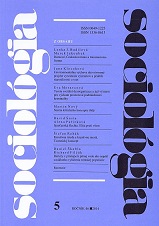Teorie sociální dezorganizace a její význam pro výzkum pro¬storové podmíněnosti kriminality
Social Disorganization Theory and its Relevance for the Socio-Spatial Analysis of Crime
Author(s): Eva MoravcováSubject(s): Social Sciences
Published by: Sociologický ústav - Slovenská akadémia vied
Keywords: social disorganization theory; socio-spatial analysis of crime; Chicago school; neighborhood crime; criminality
Summary/Abstract: Social Disorganization Theory and its Relevance for the Socio-Spatial Analysis of Crime. Research on the socio-spatial analysis of crime reaches deep into the past. However, one of the first major sociological theories that influenced the scientific field of criminology is the social disorganization theory of Shaw and McKay, who studied the impact of structural factors on neighborhood crime in the Chicago metropolitan area. This article introduces the original concept of social disorganization theory, describes the reasons for its criticism in the 70´s and the causes of its subsequent resurgence during the 80´s. Attention is given to studies that used social disorganization theory as a starting point for the socio-spatial analysis of crime. The aim of the article is to trace how the concept of social disorganization was historically understood and operationalized within empirical research, and what data the authors used for this purpose. Sociológia 2014, Vol. 46 (No. 5: 534-553)
Journal: Sociológia - Slovak Sociological Review
- Issue Year: 46/2014
- Issue No: 5
- Page Range: 534-553
- Page Count: 20
- Language: Czech

